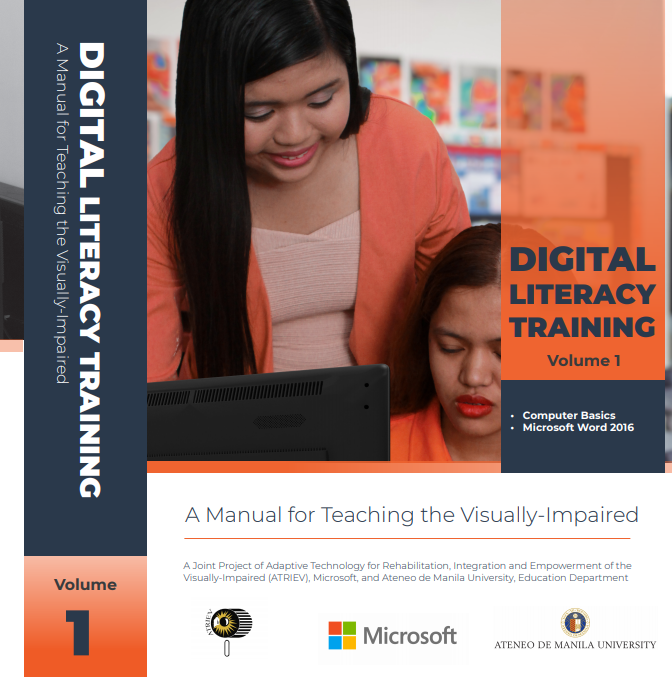Volume I – Unit 1: Computer Basics

Session 1: Getting Familiar with the Keyboard
A. Introduction
The keyboard is one of the main ways that we often use to enter commands, texts, numerical data and other types of data on the computer. As a visually impaired person, you will be using the keyboard more often than the other input devices of the computer, so it is important that you acquire the knowledge and skills of typing using the keyboard.
The keyboard varies in types and differs on the number of keys, although the standard desktop keyboard has 104 keys.

In this session, we will discuss the different parts of the keyboard, apply the proper finger positioning and explain the various ways of performing basic keyboard commands in operating the computer through the help of a screen reader.
B. Specific Objective
At the end of this session, the trainees should be able to:
- Explain the functions of the different parts of the keyboard.
- Apply the proper finger positioning on the keyboard.
- Execute some basic keyboard commands to operate the
C. Materials
- Laptop/desktop
- Headset
- Speaker
- Notepad
- Standard keyboard
D. Activities
2. Lecture: Parts of the Keyboard
The keyboard has different keys and is organized according to function:
- Typing area or alphanumeric keys: It is the largest part of the keyboard which includes similar letters, numbers, punctuations, and symbols that are also found on a traditional typewriter.

- Control keys: These are keys that can be used alone or in combination with other keys to perform particular tasks (e.g. Ctrl, Alt, Shift, Windows logo key and Esc).

- Function keys: These are the keys that can perform a certain task depending on the active program; these keys are labeled as F1 to F12 and are usually found on the uppermost part of the keyboard.
![]()
- Navigational keys: These are keys used to edit or move around a document, an application or a webpage that includes the arrow keys, home, end, page up and page down.

- Numeric keypad: The group of numbers found on the right side of the keyboard which can also be navigational keys when the Num lock key is turned off.

Have the trainees touch the keys on every part of the keyboard as you go along with the discussion. Mention the name of the keys and describe its features and location.
Emphasize that these are the different parts of the keyboard. Now let us apply the proper finger positioning for you to practice typing.
3. Demonstration: Proper Finger Positioning
First, I want all of you to raise both of your hands. Then touch your keyboard and find the two keys with embossed dots. Did you find it?
Using your left and right pointer finger, touch the two keys with embossed dots. The key with a dot on the left is the F key while the key with a dot on the right is the J key. Those keys are what we call the home keys.

We call F and J home keys because these will be our point of reference every time we get back to our keyboard. The row where the F and J are located are called home row keys.

The rest of the fingers will touch the other keys on the same row. Using your left hand, the following fingers will press these keys:
- Pointer finger – F
- Middle finger – D
- Ring finger – S
- Pinky finger – A
- Thumb – Spacebar

Using the right hand, place your fingers on the following keys:
- Pointer finger – J
- Middle finger – K
- Ring finger – L
- Pinky finger – Colon
- Thumb – Spacebar
This will be the primary position you have to remember when learning the proper finger assignment on the keyboard. Try to memorize the keys on the keyboard and practice to be an effective touch typist.
You can download the full version of this lesson through this link: Volume I – Unit 1: Computer Basics
Want a full version of this manual? Join our training of trainers. Watch-out for the announcements of trainings here on our website or like and visit our official Facebook page at https://www.facebook.com/atrievofficial.
See you there!
